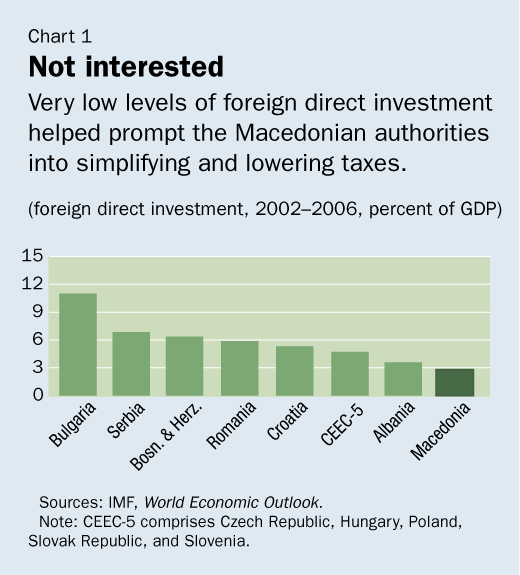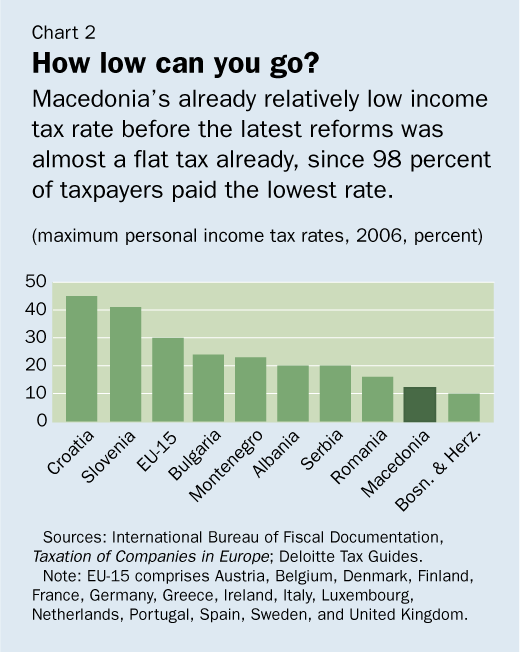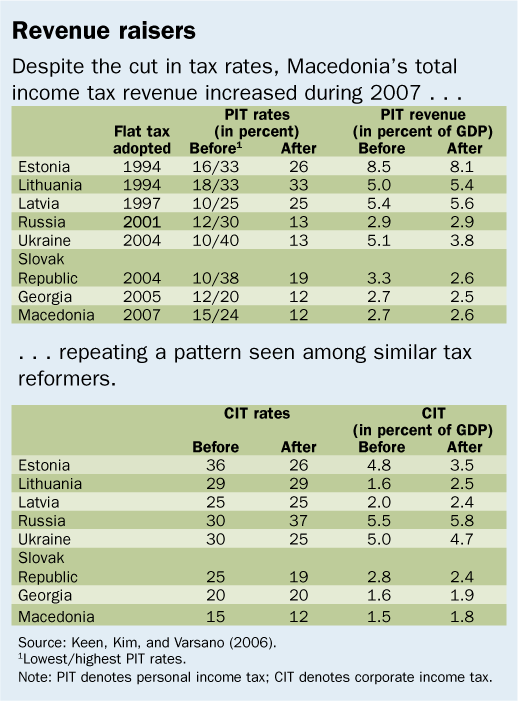
Typical street scene in Santa Ana, El Salvador. (Photo: iStock)
IMF Survey: Macedonia Makes Early Headway After Flat Tax Debut
April 30, 2008
- Macedonia has joined the club of flat tax reformers in Eastern Europe
- Revenue collection and foreign investment are up, joblessness down
- Future reforms need to cut labor tax wedge, address informal sector
Macedonia's government has early evidence of positive results from tax reforms intended to help lower unemployment and boost investment.

Roadside stall in Tetova, Macedonia: high tax wedge likely contributes to country's large informal sector (photo: Eileen Kovchok/Newscom)
TAX REFORM IN TRANSITION ECONOMIES
Elected in August 2006 on a manifesto commitment to reduce the unemployment rate of close to 40 percent and to increase foreign direct investment (FDI) from very low levels (see Chart 1), the government aimed to achieve this through a more efficient tax system, with transparent, simple, and lower taxes.

Assessment of tax reforms
Unification of personal income tax (PIT) and corporate income tax (CIT) at flat and lower rates. The objective was to simplify the tax system and to encourage beneficial supply-side effects and better compliance. However, given that 98 percent of taxpayers were paying the lowest PIT rate of 15 percent, and with this rate the same as the CIT rate, Macedonia already had, in substance, a flat tax before this reform. And its rate was already quite low compared to other countries in the region (see Chart 2).

Zero taxation of reinvested profits. The goal was to foster corporate investment by allowing reinvested profits to be deducted from the CIT but with no further deductions for depreciation allowances. Aside from threatening the base of the CIT, this also creates a "lock-in" effect so that profits are left in the company, even if more profitable investments are available elsewhere. However, the elimination of the double deduction protected revenues and also removed a significant tax distortion.
Increase tax concessions in free economic zones. The motivation was to provide tax incentives for investment in Macedonia. However, the empirical evidence shows that tax incentives are only one factor that investors take into account. Moreover, many of the tax concessions may be incompatible with EU regulations, which might complicate eventual accession.
Simplified CIT regime for small enterprises aims to reduce compliance costs for tax payers and collection costs for the tax authority, which were excessive compared to revenue generated. The use of a flat rate of 1.5 percent of the turnover is in line with best practices in tax design.
Recent tax policy reforms
• Unification of personal income tax (PIT) and corporate income tax (CIT) rates at a flat 12 percent rate from 2007, falling to 10 percent from 2008
• Zero taxation of reinvested profits with no further deduction for depreciation allowances from 2007
• Increasing tax concessions in free economic zones from 2007
• Harmonizing minimum social insurance contribution (SIC) bases from July 1, 2007
• Reduction of value-added tax (VAT) from 18 percent to 5 percent on computers, medicines, and public transportation from October 1, 2007
• Introduction of a presumptive tax for small enterprises from 2008
Harmonization of minimum social contribution bases. In the previous system, minimum pension and unemployment contributions bases were set at least equal to 65 percent of the average wage of the economy, but health contribution bases were sector and skill specific, generating cumbersome computational work for employers and creating scope for evasion. The new system brings health contribution bases in line with the other social funds.
Lower value-added tax (VAT) for computers, medicines, and public transportation. Although many countries do provide lower VAT rates for these goods, international experience suggests that administrative and compliance difficulties weaken the case for multiple VAT rates.
Preliminary outcomes
Despite the rate cuts, income tax revenue increased during 2007. PIT revenues fell slightly as a fraction of GDP. The same pattern was observed in Estonia, Georgia, Ukraine, and the Slovak Republic (see table). CIT revenues increased (in line with the experience of Lithuania, Latvia, Russia, Georgia, and Estonia), but much of this is due to a substantial (30 percent) increase in reported profits.

In terms of the main goals pursued by the government, the preliminary evidence is positive. While the unemployment rate fell only slightly during 2007 (from 36 to 35 percent), green field FDI increased from 1.2 percent of GDP in 2006 to a projected 4.1 percent in 2007.
Labor taxes next
Despite the lower PIT rate, the labor tax wedge—that is, the tax share of labor costs— is still high and very likely contributes to the high unemployment rate and large informal sector. A World Bank report documents that the tax wedge is relatively high in Eastern Europe.
The main cause is social insurance contributions which account for more than two-thirds of the wedge. Health care contributions of part time workers, for example, are calculated assuming a full time workweek making formal part-time employment extremely expensive for the employer.
The size of the labor tax wedge grows exponentially for lower wages because of high minimum contributions. The government should use any fiscal margin to link social contributions for low wage workers to their actual earnings. These measures will encourage formality and reduce unemployment for those with less marketable skills.
Comments on this article should be sent to imfsurvey@imf.org


